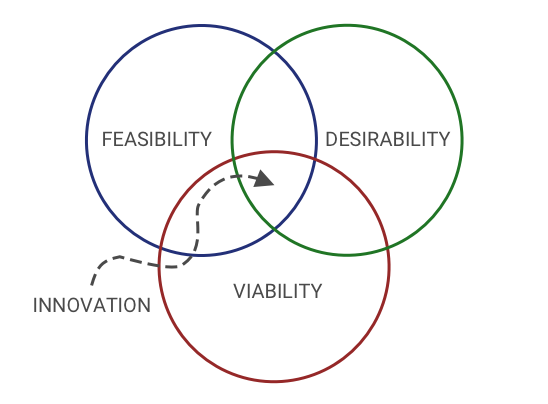The definition of the word design is very broad and might a bit confusing. There is Product design, Industrial design, Design systems, Graphic design, User experience design… and on top of many others there is Design thinking.
Design Thinking definition
Design thinking is the methodology that is used to solve complex problems and it is a way of using systemic reasoning and intuition to explore ideal future states.
Design thinking, brings together three essential areas – what is desirable with what is technologically feasible and economically viable.

- Technical Feasibility – What is functionally possible within the foreseeable future?
- Economic Viability – What is likely to become part of a sustainable business model?
- Human Desirability – What makes sense to people and for people?
Design thinking is a human-centered approach to innovation that draws from the designer’s toolkit to integrate the needs of people, the possibilities of technology, and the requirements for business success.”
— Tim Brown, CEO of IDEO
Design Thinking Process
The Design Thinking process is based on the workflow process of five phases.

The diagram above shows five components of design
thinking.
Design Thinking Stages
Empathise step
Empathy is the foundation of Design Thinking. Build empathy for your users’ needs and problems by learning their values.
- Interviews
- Shadowing
- Seek to understand
- Non-judgemental
Define step
Transform your empathy findings into needs and insights and form a meaningful challenge.
- Personas
- Role objectives
- Decisions
- Challanges
- PainPoints
Ideate step
Explore a wide range of solutions, large quantity and broad diversity of ideas.
- Share ideas
- All ideas are worthy
- Diverge/Converge
- “Yes and” thinking
- Prioritize
Prototype step
Transform your ideas into tangible prototypes. Keep prototypes inexpensive and low-fidelity to learn quickly and explore multiple possibilities.
- Mockups
- Storyboards
- Keep it simple
- Fail fast
- Iterate quickly
Test step
Iteratively test to gather feedback quickly, refine solutions, and learn more about your users.
- Understand impediments
- What works?
- Role play
- Iterate quickly
Design thinking is about getting to the root of a problem,
Prof. Hasso Plattner, Co-creator of Design Thinking
rather than just treating some of the symptoms.
Credits
Design Thinking was developed by David Kelley, Stanford professor and founder of the renowned design agency IDEO in Silicon Valley, and is strongly influenced by Professors Terry Winograd and Larry Leifer at the d.school at Stanford University.
